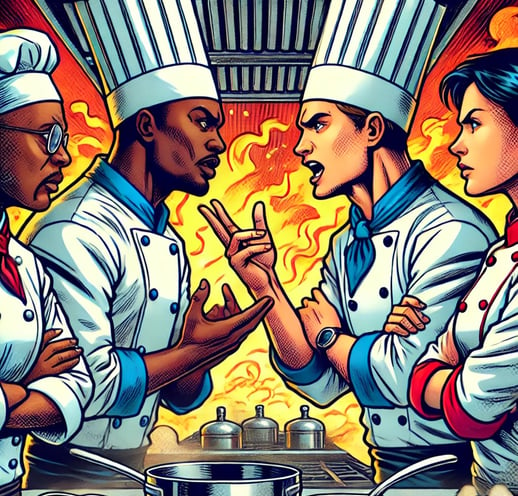

Kitchen Warzone:
How to Lead and
Stay Cool Under Fire
Steve Weiss, ACC
Transformational Leadership Academy
The back of house (BOH) in a professional kitchen is not just a workplace; it's a pressure cooker of heat, noise, and adrenaline. As Chef Anthony Bourdain once wrote, “The professional kitchen is the last refuge of the misfit. It's a place of immense stress and absolute focus, where only the strong survive.” Yet, even the strongest can falter when tensions boil over. So how does a leader or team member in the BOH maintain grace under fire when chaos ensues?
This article dives into real tactics and strategies to keep calm and lead effectively when the pressure is on, with lessons drawn from seasoned professionals and data-backed insights.
The Stakes in the BOH: Why Composure Matters
The kitchen is a battlefield where every moment counts. Orders pile up, tickets blur into one another, and mistakes snowball. A single overreaction from a leader or team member can throw the entire kitchen into disarray, amplifying stress and diminishing morale.
A 2022 study by the Culinary Institute of America found that kitchens with calmer, emotionally intelligent leaders saw a 25% reduction in errors and a 40% improvement in team morale compared to those led by reactive individuals. Emotional composure isn’t just about "staying calm"—it’s a measurable factor in kitchen performance.
In-the-Moment Tactics for Staying Composed
1. Anchor Yourself Physically
The physiological response to stress—rapid heart rate, shallow breathing, tense muscles—can derail your focus. Combat this with physical grounding techniques:
Box Breathing: Inhale for four counts, hold for four, exhale for four, and hold again for four. This technique, used by Navy SEALs in high-stress situations, reduces cortisol levels and sharpens focus.
Reset Posture: Roll your shoulders back, unclench your fists, and plant your feet firmly. A relaxed posture sends calming signals to your brain.
2. Take a Mental Pause
When orders are flying and mistakes happen, taking even a two-second mental pause can make a difference. Ask yourself:
“What’s the next right step?”
“What needs immediate attention, and what can wait?”
Chef Thomas Keller famously said, “A good leader is like a duck—calm on the surface but paddling furiously beneath.” Taking that mental pause allows you to exude calmness while swiftly prioritizing actions.
3. Flip the Script on Negative Talk
When blame or panic begins to dominate the kitchen atmosphere, a simple reframing can diffuse tension. Replace:
“Why did this happen?” with “What can we do right now to fix it?”
“Who screwed this up?” with “Let’s get this back on track."
Hypothetical Example:
A sous chef botches a sauce for a VIP table. Instead of shouting, “How could you mess this up?” the head chef says, “Alright, this needs a redo. Can you start fresh while I plate the other elements?” This quick reframing maintains momentum and avoids spiraling into finger-pointing.
Handling Poor Reactions from Others
1. Dealing with Blame from Above
When a superior reacts poorly under pressure:
Acknowledge Their Frustration: A simple, “Got it, Chef—I’ll fix it right now” acknowledges the urgency without fueling the fire.
Follow Up Later: After service, approach them calmly. “Chef, during the rush, I felt the pressure got to both of us. I’d love to discuss how I can improve next time.”
2. Managing Meltdowns from Peers
If a coworker starts losing their cool:
Mirror Calmness: Lower your voice and slow your movements to model a calming presence.
Redirect Their Focus: Use task-oriented phrases like, “I’ll handle the garnishes if you can finish that protein.” Giving them a specific action can refocus their energy.
3. Supporting Subordinates in Crisis
When someone you lead is cracking under pressure:
Pull Them Aside Briefly: Even 30 seconds out of the fray can help them reset. Say, “Take a breath. Let’s get through this together.”
Coach Through the Moment: Avoid micromanaging; instead, provide clear, actionable steps. “Focus on plating this one dish perfectly, and we’ll move forward from there.”
Building Long-Term Composure Skills
1. Practice Pre-Service Visualization
Before the rush, take 5-10 minutes to mentally walk through the service. Visualize challenges, and imagine yourself responding calmly. Studies on elite athletes show that visualization improves performance under pressure by 20-30%.
2. Develop Emotional Agility
Emotional agility—the ability to adapt your response to stress—comes from building self-awareness. Journaling after service or debriefing with trusted colleagues can help you identify triggers and improve reactions over time.
3. Create a Culture of Feedback
Establishing a culture where feedback is routine and respectful can reduce in-the-moment blowups. Regular team check-ins foster trust and allow small issues to be addressed before they escalate.
The Calm in the Chaos
Grace under fire is not about being emotionless but about channeling emotions into purposeful action. As Chef Dominique Crenn said, “In the kitchen, we work together toward the same goal. Grace, respect, and love for what we do—that’s what makes us great.” By grounding yourself, reframing challenges, and fostering a culture of composure, you can lead your team through the heat with professionalism and poise.
Contact Info
steve@leadwithtla.com
216-288-4548
